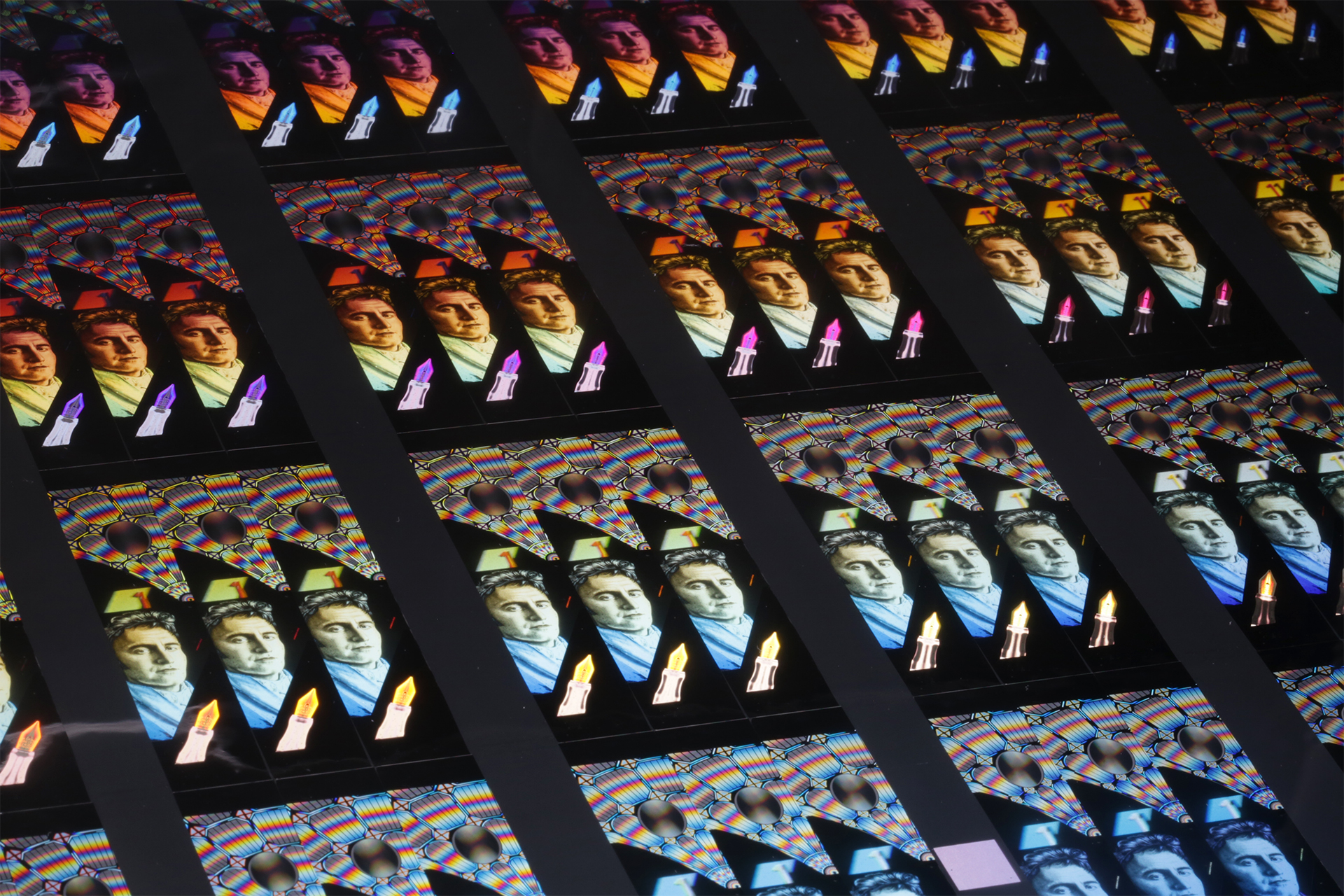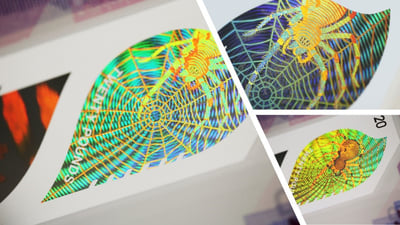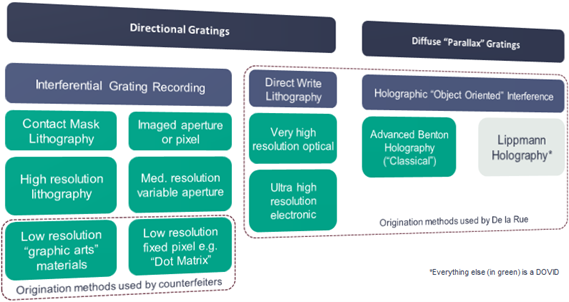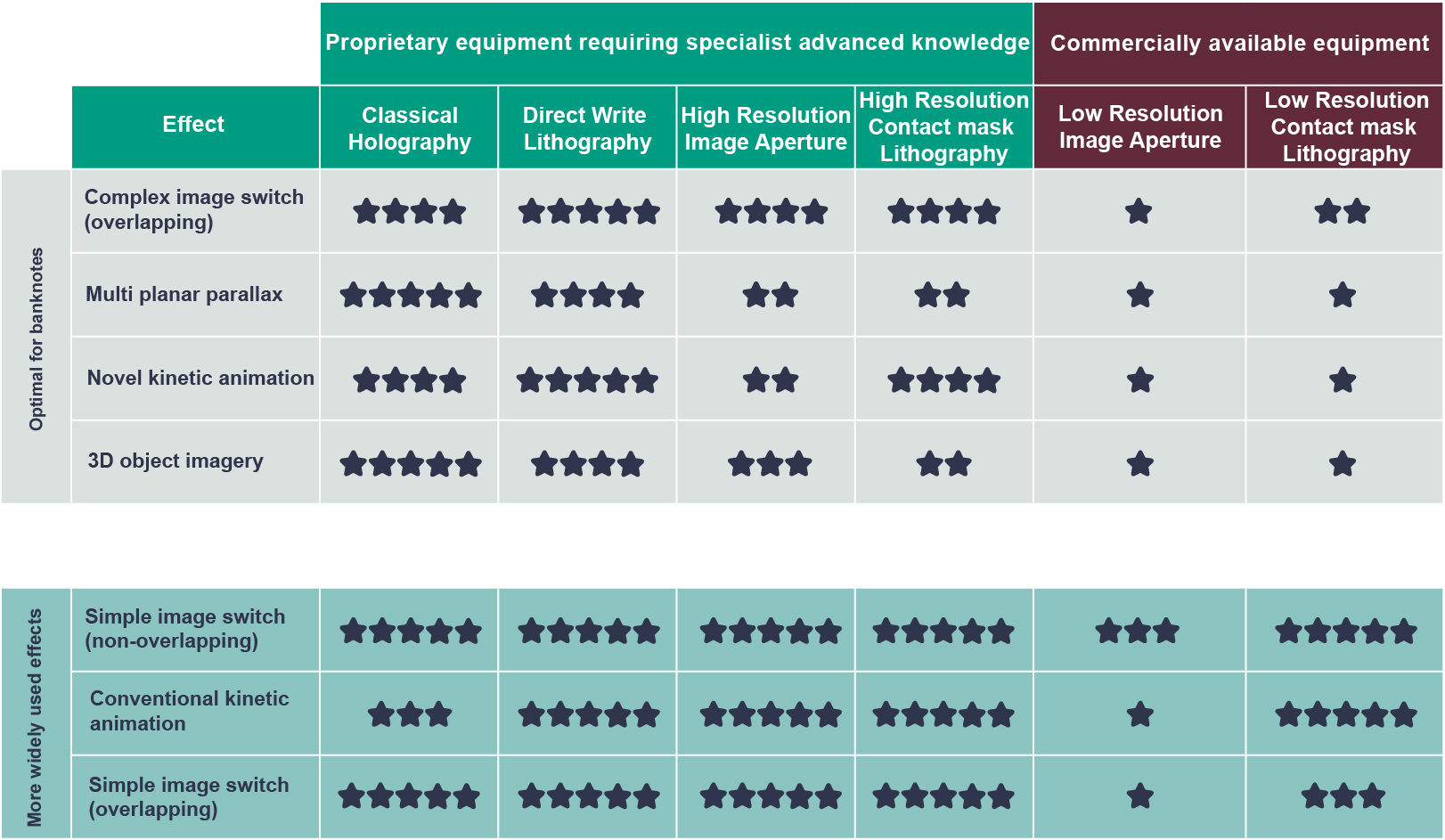What's the difference between a hologram and a "banknote secure" hologram ?
Dr Nikki Strickland, Group Director Marketing & Strategy
Bring the art in your banknotes to life with secure animations, depth perception and innovative movements.
The need to stay ahead of counterfeiters has led to decades of investment and progression across all the major security feature technologies (i.e. holographics, colourshift and micro-optics). Commercial entities have caught up with some of the simpler/older variants of this technology, which means that criminals today have access to generic decorative variants of every type of public recognition banknote security feature.
Crude ‘bling’ or colour copies of a security feature don’t normally fool members of the public but it is important for banknote security features to be significantly different to products that are available commercially. This means they need scientifically advanced and customisable effects that can be integrated into distinctive, intuitive and unique designs.
Good security features need to be obviously different from anything that can be created using commercial materials.
De La Rue’s expertise covers material science, optical security and design, providing innovative security features based on all the major banknote security technologies. This means that De La Rue is well placed to understand the relative benefits of each technology platform and support banknote issuing authorities as they select the optimal combination of security features for their future banknotes.
This article focuses on the specific benefits of De La Rue’s secure banknote holograms.
Why you may be confused about "holograms"
The word “hologram” is used in two different ways, which has led to some misconceptions about them as a security feature. The original scientific definition, based on the pioneering work of Dennis Gabor in the late 1940s, is the recording of an interference pattern between two coherent beams of light, one of which has been reflected or transmitted from an object.[1] More recently the word “hologram” has also become an umbrella term for a wide range of first order diffractive devices created by different origination methods and used for a range of applications (security, decorative and novelty).[2]
Throughout this article we use the common broader definition of a hologram unless otherwise stated.

Holographic shim, 1st Edition Feature Series Foil on Polymer

The use of the word hologram as a general umbrella term has caused confusion, with some central banks wrongly assuming all holograms are equivalent and based on old technology. This couldn’t be further from the truth - the advances in holography have been significant and some security features known as holograms today are highly sophisticated and scientifically advanced. The technology behind every other security feature sold today also has its origins in the middle of the 20th century and have also evolved over time; in this sense holography is no different than colourshift or micro-optics. Every good security feature is based on a technology that goes back decades but has advanced significantly over time.
The Benefits of Secure Holograms
Every security feature has specific benefits, which is why it is important to layer a range of security features through a banknote, using an evidence-based approach to understanding the best security feature combination for that banknote. Holograms are frequently used as the main public recognition security feature on banknotes but are versatile enough to also play a supporting role when it better suits the needs of that banknote. They protect billions of banknotes, including banknotes issued by many G20 countries.
Holograms offer the following five main benefits:
- They are fully customisable – virtually any graphical element or image can be incorporated into a hologram and made secure with an effect. A spider can crawl across a web and photo realistic models of a person can be captured in full three-dimensions. Holograms can take on the form of a patch, stripe or thread to protect a banknote and demetallisation techniques enable those product formats to adopt intricate and highly customised shapes.
- Holographic images lose their optically variable effects upon copying. This includes the loss of moving iridescent colour changes, which is unique to holograms. They will also lose graphical animation and three-dimensional effects.
- The individual images and effects used in banknote holograms are based on more than simple icons or shapes – they are secure pieces of multi-dimensional art allowing for photorealistic and three-dimensional images. The human brain responds strongly to images, especially faces; this means any simulation of holographic imagery must replicate multi-dimensional detail at an extremely high level of precision.
- A single holographic feature protects a banknote in many ways by combining multiple contrasting effects which all require different steps to simulate. For large area holograms it is even possible to combine effects requiring two different origination approaches thus doubling the counterfeiting barrier. Any attempt at re-origination of secure holograms requires equipment, algorithms, skills, knowledge and techniques that are not available commercially.
- In polymer banknotes the holograms protect both sides of the note when placed in the window. Most security features only protect one side of the note, so this makes a hologram a particularly effective polymer security feature and gives you two-for-one value for money.
The Evolution of Secure Holograms
Security feature development has long been considered an arms race against counterfeiters. Banknote issuing authorities and suppliers like De La Rue continue to invest to secure and future-proof their products. Criminals embrace the latest commercially available equipment and know-how, meaning that security features must stay ahead of (and be different from) what can be generated commercially.
Any timeline showing the history of holograms on banknotes (Figure 1) typically begins with the Australian Catpix™ feature and Austrian Kinegram® in the 1980s. Patents from the time tell us that these are diffractive devices (i.e. they would typically fall under the generic umbrella term hologram as defined above), although the Kinegram® is very clearly specified as not being a hologram. The incorporation of true holograms (as per the official scientific definition) onto banknotes were a more modern development, first appearing in the 1990s.
Secure banknote holograms (in the broader sense of the definition) have progressed to stay ahead in the technology arms race, with the security focused evolution taking two different approaches in parallel.
The first approach is a proprietary approach. This applies to holograms that are true to the original scientific definition (“classical” holograms, also called “Advanced Benton H1-H2 Image Plane” holograms). They require expensive specialist equipment, proprietary materials, advanced scientific knowledge and skills that are now scarce. There are analogies here with watermarks, which are about 800 years old and intaglio, which is about 500 years old. Watermarks require a secure and expensive paper mill. Digital printing doesn’t yet replicate the intensity of colour or the distinctive tactility of intaglio print. Classical holography is just as proprietary, but with the additional security benefits of also being optically variable.
The effects generated by “classical” and digital “holograms” have progressed over time, moving from simple switching effects to dynamic, intuitive and interactive security features. The growing popularity of polymer substrate provides a smooth surface that unlocks further effects and design possibilities. Design expertise has progressed to make holograms more engaging and intuitive. Foil carriers have become more durable and more customisable. Demetallisation techniques have evolved so that simple solid patch or stripe shapes have become significantly more intricate and integrate better in the design. Colours have been introduced and holograms have been integrated into various banknote windows. Different application methods have emerged. The effects have become more impactful, more engaging, more colourful and visible across a wider viewing angle. This progression continues, with increasingly more photorealistic images, moving colour and engaging animated effects.
Polymer banknotes gain additional benefits over paper when they incorporate a hologram into their window - the hologram protects both sides of the banknote and the smooth non-porous surface of the polymer substrate enables new effects.

Figure 1. Evolution of holographic features
Holographic technology has progressed to offer the largest range of product formats, application approaches, effect types and customisation options of any technology available.
So what are the different types of holograms?
The generic term hologram includes a range of diffractive devices that are based on gratings (in green in Figure 2) as well as Lippman holography (used in De La Rue Authentication solutions). There is a range of origination methods available for creating those gratings (Figure 2).
The types of grating and the way those gratings are generated broadly dictates the strengths and weaknesses of the various systems when it comes to producing different types of holographic effects. Each column tends to have similar strengths and weaknesses. So, broadly speaking, the type of effect you want to achieve points you towards the best origination method to use.
The type of effect you want to achieve points you towards the best origination method to use.
The more commercially available holograms tend to be based on low resolution “graphic arts” materials (low resolution contact mask lithography) or low-resolution fixed pixel originations (“dot matrix”). These methods lend themselves to simpler switching and more standard graphical animation effects.
De La Rue focusses on direct write lithography (an advanced type of digital “hologram” enabling precise control of the grating structure) and a highly evolved form of Benton (H1-H2) holography (“classical” holography). This allows the boundaries to be pushed using methods and capability that remain outside of the limits of commercially available machines. It also enables effects that are virtually impossible to re-originate convincingly using the standard counterfeiting equipment.

Figure 2. Classifications of Holographic Origination Methods
De La Rue’s holograms use an advanced digital holography, called direct write lithography, which enables precise control of the grating structure and a highly evolved form of Benton (H1-H2) holography (“classical” holography). Both enable novel and secure effects. In contrast commercial holograms use low resolution contact mask lithography or low-resolution fixed pixel originations (“dot matrix”)
Relationship Between Holographic Classifications and Effects
Secure banknote holograms are created by generating effects that commercially available equipment struggle but where classical and direct-write methodology thrive. The various strengths of the different origination methods are summarised in figure 3.
Depth effects, photorealism and advanced kinetic animation are a core part of a secure holographics offering because they require classical and direct-write methodology. “Classical” holography is the recording of an interference pattern between two coherent beams of light, one of which has been reflected or transmitted from an object. This hologram is at the intersection of art and science, creating detailed three-dimensional images and parallax effects that transition through every colour as the banknote is tilted. “Classical” holograms lend themselves particularly well to depth effects, parallax, photorealism and discrete animations (e.g. a three-dimensional owl that turns its head and winks).
Direct write “holography,” through precise control of grating structure, creates strong, interactive and engaging kinetic effects as well as complex image switches. Direct-write origination techniques produce diffractive devices that aren’t pure “holograms” according to the original scientific definition. However they are much more than the simple commercial digital techniques. The positioning and interlacing of the elemental gratings they produce are particularly well suited to the creation of animated graphics that can be clearly viewed over wide angles. Whilst certain standard animated graphics are well suited to dot-matrix digital holography machines the main feature produced via direct write holography is non-standard.
-Kingfisher-hologram-intaglio-detail.png?width=400&height=400&name=Kingfisher-housenote-(2014)-Kingfisher-hologram-intaglio-detail.png)
The effects possible with De La Rue’s Direct Write Lithography and Classical holography cannot be matched using contact mask lithography and image aperture origination methods.

Figure 3. Quality of effects generated using different origination equipment types
Counterfeiting Holograms
Holograms are well known and well-remembered, so criminals often feel the need to make the effort to try to simulate the foil in some way. The counterfeiter is not interested in how the genuine device was made – they simply want a simulation that can pass. This means that design also plays a fundamentally important role in securing the feature.
As designs get more complex they risk becoming harder to explain, making it harder for the public to recognise right from wrong, which paradoxically make poorly designed holograms easier to simulate with a “good enough” image. Good design plays a critical role in the security of a hologram, enabling the combination of effects that are hard to simulate with a feature that is obvious, easy-to-remember and intuitive.
In most instances the counterfeiter doesn’t even attempt to simulate the holographic effect. Most banknote counterfeits seen by De La Rue are based on a simple decorative foil or a more complex and therefore time-consuming approach based on laser printed decorative foils-printed fusers. Commercially available holograms may be used but won’t match the image or effects of the genuine hologram. These types of counterfeits may have some ‘bling’ on the banknote but this bling doesn’t look like it belongs and so is typically noticed quickly and removed from circulation. The members of the public are not easily tricked.
More sophisticated attacks are rare, but they also struggle to emulate the quality and range of effects of the secure holograms used in genuine banknote due to the nature of the origination methods commonly used by criminals. The counterfeiters typically use low resolution “graphic arts” materials originations (low resolution contact mask lithography) or low-resolution fixed pixel originations (“dot matrix”). These methods lend themselves to simpler switching and more standard graphical animation effects but struggle with some of the effects used in secure banknote holograms.
Combining hard-to-simulate effects with intuitive design is essential to minimise the counterfeiting risk and create a hologram that is easily remembered by the public.
Good Design Remains Core to Good Security
Secure banknote holograms require strong effects that are resilient to re-origination simulation. Complimentary effects require different and specific simulation and so each one creates an additional barrier for the counterfeiter. Combinational holograms – holographic stripes or patches that incorporate effects best generated by “classical” and “direct write” origination methods provide a particularly strong counterfeiting barrier. However good design is essential to ensure that the public instinctively know when they are looking at a genuine banknote and not accept a “good enough” counterfeit.
The holographic design also needs to be engaging, intuitive, easy to authenticate and impactful. As with all public recognition, level 1 security features, they need to look like they belong in the banknote. Fully integrating the foil design into the overall banknote design including related and clearly identifiable motifs, produces a more aesthetically pleasing result and makes it much more likely any counterfeit attempt will trigger a concern that something is wrong. Holograms benefit from being able to incorporate detailed imagery and link that imagery to an effect – they can be considered as a type of secure art. This is an important element in the overall anti-counterfeiting strategy as, in most cases, even a cursory examination enables counterfeit devices to be readily identified.
The first-generation feature series of housenotes shown in Figure 4 adhered to holographic design best practice for large area banknote effects. The photorealistic image and depth effect shown around Thomas de la Rue required “classical” holography. And whilst pseudo relief effects are generally a standard effect, the combination with holographic colour effects brings the Onoto fountain pen to life via direct write. PureImage™ is shaped to replicate the patterns of the Crystal Palace roof structure from the Great Exhibitionpalace, with dynamic movement effects that are striking from every angle and Spotlight™ rotates about a pivot below the plane of the hologram. Furthermore, Spotlight™ encourages engagement and interactivity with the light of a smart phone torch. Under diffuse light the images are blurred, and they become sharp under torchlight. Finally, the shape of the hologram and use of demetallisation make it harder for a hobbyist type counterfeiter to simply cut out a convincing shape of this hologram.
Figure 4. Combinational Hologram Used in the 1st Edition Feature Housenote Series
Summary
Holograms secure graphical elements and imagery in a way that is engaging and incorporates effects that can’t be replicated with normal commercially available equipment. Criminals rarely go to the effort of ordering commercially available holograms and don’t often attempt to re-originate a hologram. However, the challenge central banks face is in ensuring the hologram itself is memorable and engaging so that the public will know when something is wrong. Holograms should be the best placed of all security features to do this due to their ability to incorporate meaningful and detailed images that have effects linked to them.
The design philosophy of De La Rue is to use combinations of contrasting secure effects in a single note, whilst ensuring the design is memorable and attractive. Where possible holograms are based on both “classical” and direct write origination methods to maximise the barriers to re-origination simulation and to produce an engaging design. New effects such as Spotlight™, PureImage™ and TrueImage™ continue to progress the boundaries of “classical” and direct write origination methods.
As holographic science continues to advance we expect to see more impactful depth and animation effects, stronger colours and more intuitive dynamic effects. The response to De La Rue’s Spotlight™ feature suggests there is also scope to create more features that interact with mobile phones.
Given the increasing availability of decorative and generic variants of colourshift, micro-optic and holographic technologies, the option to use security features that can be fully customised has never been more important. De La Rue’s holograms offer fully customisable images and a diverse range of engaging, contrasting and secure effects that remain at the forefront of securing banknotes.
Please email currency@delarue.com for more information
Footnotes:
[1] The hologram name derives from the ancient Greek word ‘holos’ which means whole. It reflects the fact that in a true hologram both the phase and amplitude information from a 3D object is captured. This is distinguished from a photograph where only amplitude information is captured.
[2] Such devices use microscopic relief structures known as gratings to control the colour and direction of the light that is replayed into the observer’s eye. Such structures may be created by a true holographic method, simple two beam laser interference or by direct exposure or writing.



